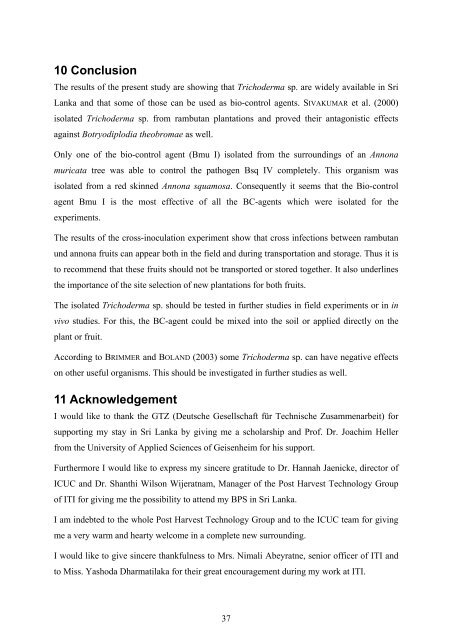Botryodiplodia sp. - Crops for the Future
Botryodiplodia sp. - Crops for the Future
Botryodiplodia sp. - Crops for the Future
Create successful ePaper yourself
Turn your PDF publications into a flip-book with our unique Google optimized e-Paper software.
10 Conclusion<br />
The results of <strong>the</strong> present study are showing that Trichoderma <strong>sp</strong>. are widely available in Sri<br />
Lanka and that some of those can be used as bio-control agents. SIVAKUMAR et al. (2000)<br />
isolated Trichoderma <strong>sp</strong>. from rambutan plantations and proved <strong>the</strong>ir antagonistic effects<br />
against <strong>Botryodiplodia</strong> <strong>the</strong>obromae as well.<br />
Only one of <strong>the</strong> bio-control agent (Bmu I) isolated from <strong>the</strong> surroundings of an Annona<br />
muricata tree was able to control <strong>the</strong> pathogen Bsq IV completely. This organism was<br />
isolated from a red skinned Annona squamosa. Consequently it seems that <strong>the</strong> Bio-control<br />
agent Bmu I is <strong>the</strong> most effective of all <strong>the</strong> BC-agents which were isolated <strong>for</strong> <strong>the</strong><br />
experiments.<br />
The results of <strong>the</strong> cross-inoculation experiment show that cross infections between rambutan<br />
und annona fruits can appear both in <strong>the</strong> field and during tran<strong>sp</strong>ortation and storage. Thus it is<br />
to recommend that <strong>the</strong>se fruits should not be tran<strong>sp</strong>orted or stored toge<strong>the</strong>r. It also underlines<br />
<strong>the</strong> importance of <strong>the</strong> site selection of new plantations <strong>for</strong> both fruits.<br />
The isolated Trichoderma <strong>sp</strong>. should be tested in fur<strong>the</strong>r studies in field experiments or in in<br />
vivo studies. For this, <strong>the</strong> BC-agent could be mixed into <strong>the</strong> soil or applied directly on <strong>the</strong><br />
plant or fruit.<br />
According to BRIMMER and BOLAND (2003) some Trichoderma <strong>sp</strong>. can have negative effects<br />
on o<strong>the</strong>r useful organisms. This should be investigated in fur<strong>the</strong>r studies as well.<br />
11 Acknowledgement<br />
I would like to thank <strong>the</strong> GTZ (Deutsche Gesellschaft für Technische Zusammenarbeit) <strong>for</strong><br />
supporting my stay in Sri Lanka by giving me a scholarship and Prof. Dr. Joachim Heller<br />
from <strong>the</strong> University of Applied Sciences of Geisenheim <strong>for</strong> his support.<br />
Fur<strong>the</strong>rmore I would like to express my sincere gratitude to Dr. Hannah Jaenicke, director of<br />
ICUC and Dr. Shanthi Wilson Wijeratnam, Manager of <strong>the</strong> Post Harvest Technology Group<br />
of ITI <strong>for</strong> giving me <strong>the</strong> possibility to attend my BPS in Sri Lanka.<br />
I am indebted to <strong>the</strong> whole Post Harvest Technology Group and to <strong>the</strong> ICUC team <strong>for</strong> giving<br />
me a very warm and hearty welcome in a complete new surrounding.<br />
I would like to give sincere thankfulness to Mrs. Nimali Abeyratne, senior officer of ITI and<br />
to Miss. Yashoda Dharmatilaka <strong>for</strong> <strong>the</strong>ir great encouragement during my work at ITI.<br />
37

















